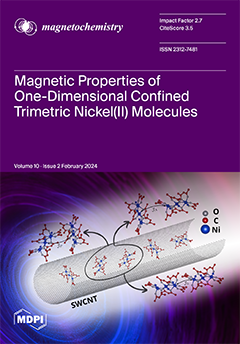Measurements of complex magnetic permeability,
μ(
f,
H) =
μ′(
f,
H) −
iμ″(
f,
H) and dielectric permittivity
ε(
f,
H) =
ε′(
f,
H) −
iε″(
f,
H), in the frequency range,
f of (0.4–7) GHz, and polarizing field,
H of (0–135) kA/m, were performed, for a kerosene-based ferrofluid with magnetite nanoparticles. Based on these measurements, the phenomenon of ferromagnetic resonance was highlighted and some microwave propagation parameters of the ferrofluid were determined: the attenuation constant,
α(
f,
H), and the reflection coefficient,
R(
f,
H), at the air-material interface, at the normal incidence. Knowing these parameters we proposed a theoretical model establishing for the first time an equation that allows the calculation of the overall reflection coefficient,
Rw(
f,
H), at the normal incidence of the wave, for a ferrofluid of thickness
d, deposited on a totally reflective support, following multiple internal reflections of the electromagnetic wave in the material. The results show that by increasing both,
H, and
d, the parameter,
Rw(
f,
H) presents a minimum that decreases from 0.90 (for
d = 2 mm) to 0.64 (for
d = 10 mm), at frequency
f = 5 GHz, which indicates an increase in the absorption of the electromagnetic wave by the ferrofluid. The obtained results are useful in the study of some materials that could be used as electromagnetic absorbers in the microwave range, by the determination of the overall reflection coefficient,
Rw(
f,
H), controlled both by the thickness,
d, of the absorber and by the external applied field,
H.
Full article





